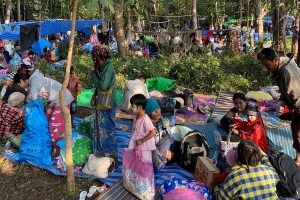On April 4, residents in Kawkareik township, Karen State (also known as Kayin State) awoke to heavy artillery fire by the junta’s 97th Infantry Battalion. A 17-year-old girl was struck by the shells and was killed on the way to the hospital. Four others were seriously injured.
The strikes were only the latest in a series of ongoing, relentless attacks against civilians in southeastern Myanmar. The Karen National Liberation Army, an armed wing of the Karen National Union (KNU), confirmed that the junta’s fighter jets had attacked Kyeik and Paikaldon village tracts, an area held by the KNLA’s 6th Brigade. The fighting continued through the first week of the month, forcing roughly 600 villagers to flee in at least four airstrikes over the last month.
Just days before, on March 31, the junta shelled a residential area in Taung Kya Inn village, Kawkareik township, damaging houses and a temple. Luckily, no one was injured, though survivors looked upon their demolished homes and, overcome with sadness, began to break down in tears.
This is just one dark scene that played out in just one of Myanmar’s many conflicts. There are countless others taking place – and the world should not forget. The military has not hesitated to fire machine guns and highly sophisticated weaponry into civilian areas. Bunkers have been dug in local areas as a last-minute attempt to seek safety and shelter.
On April 10, more violence from the junta wreaked havoc in Lay Kay Kaw when members of the Myanmar military launched more airstrikes along the Thai-Myanmar border. Rather than adhere to orders by the KNU to retreat, the Myanmar army continues to send in more reinforcements. There were reports that chemical weapons were used by the junta during the most recent outbreak of clashes. If confirmed, this would amount to among the most serious human rights violations yet.
The rapidly deteriorating human rights situation in southeastern Myanmar requires urgent and immediate attention as more lives are caught in the crossfire every day. Innocent people are being deliberately targeted by the military junta. In Kawkareik township alone, a total of 12,177 people were forcibly displaced by the end of March due to the military junta’s ongoing offensives.
The Human Rights Foundation of Monland (HURFOM) has been documenting human rights violations in southeastern Myanmar for decades, specifically in Mon and Karen States and Tanintharyi region. Since the attempted coup on February 1, 2021 in which the military junta arrested leaders of the civilian government, HURFOM has observed a significant increase in atrocity crimes being perpetrated against civilians.
In addition to indiscriminate firing upon innocent civilians, locals have been stopped at checkpoints and have had their belongings confiscated. At least 500 motorcycles have been stolen by the military junta, in addition to millions of Myanmar kyat extorted from civilians during “stop and frisk” tactics deployed at checkpoints. Mobile devices are also regularly taken and searched for any evidence of pro-democracy involvement.
Forced disappearances are on the rise, and human rights defenders are under attack, often forced into exile. Alongside increasing surveillance, HURFOM has documented that local people in southeastern Myanmar are living in constant fear, with no protection, no security, and no rule of law.
By the end of March 2022, HURFOM reported over 67 people were arrested, more than 50 unlawfully detained, 23 injured, and eight were killed across our target areas. The soldiers responsible for these ongoing crimes have not been held accountable, nor have they faced any type of repercussions for their mass injustices.
Even children have not been spared by the junta’s attacks. In a deadly assault on March 29, which was deliberately filmed by the Myanmar military, two brothers (age 6 and 8) were killed in Thaton Township, Kamar Sai village, Mon State when long-range heavy artillery shells were fired during a clash with the KNLA.
The crisis has again forced thousands to seek refuge along the Thai-Myanmar border, where Thai authorities have failed to act on humanitarian grounds. Makeshift shelters established along the Moei river are easily damaged by the persistence of heavy rain. A lack of clean water and food has led to the spread of disease, particularly among young children and the elderly.
The military junta has continued to fail the people of Myanmar. HURFOM reporting has led to the conclusion that without serious repercussions and intervention by the international community to hold the military accountable, human rights violations will continue with impunity.
But there is still time to act. The long-awaited Burma Act was recently passed in the U.S. House of Representatives, which provides pathways for more sanctions and funding to human rights organizations. This important step forward must propel international bodies, including the United Nations, to act with urgency. As Myanmar’s generals continue their warpath of destruction, civilians are paying the ultimate cost. Justice has already been delayed and denied for too many, for too long.
International actors and U.N. bodies must support and enact a no-fly zone in Myanmar, in addition to a global arms embargo, as well as an urgent and immediate referral of the situation on the ground in Myanmar to the International Criminal Court.
































